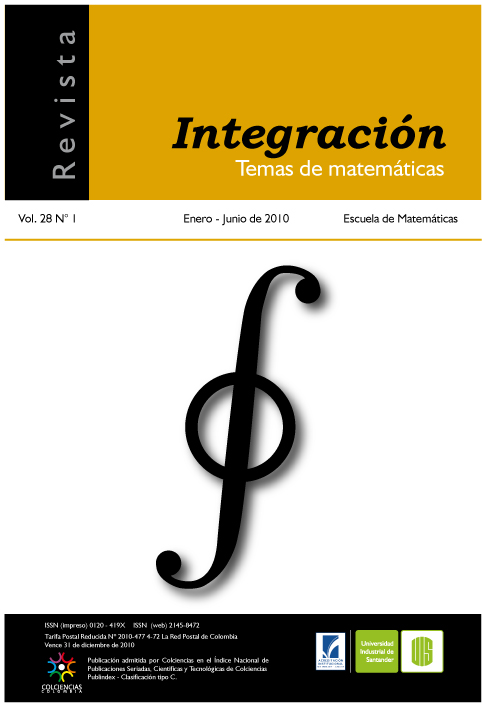Artículos científicos
Publicado 2010-06-09
Palabras clave
- Muestreo,
- estimador lineal,
- estimador de Neyman,
- Horvitz y Thompson,
- Godambe y Stanek
- Singer y Lencina ...Más
Cómo citar
Moreno, G., & Lemonte, A. J. (2010). Relación entre algunas clases de estimadores lineales. Revista Integración, Temas De matemáticas, 28(1), 51–65. Recuperado a partir de https://revistas.uis.edu.co/index.php/revistaintegracion/article/view/2059
Resumen
Se propone una forma diferente de representar la información de una realización muestral. En este nuevo enfoque, una realización muestral está representada por un objeto matemático común que permite identificar la forma en que la información muestral está siendo usada en la construcción de los estimadores lineales. Se presenta la relación existente entre las principales clases de estimadores lineales propuestos en la literatura: Neyman, Horvitz y Thompson, Godambe y Stanek, Singer y Lencina.
Palabras claves: Muestreo, estimador lineal, estimador de Neyman, Horvitz y Thompson, Godambe y Stanek, Singer y Lencina.
Descargas
Los datos de descargas todavía no están disponibles.
Referencias
[1] Bolfarine H., and Zacks S., “Prediction theory for finite populations”, Springer Verlag, New York, 1992.
[2] Cochran W. G., “Sampling Techniques”, 3rd Edition, Wiley, New York, 1977.
[3] Godambe V.P., A unified theory of sampling from finite populations, Journal of The Royal Statistics Society, Series B, 17 (1955), 269-278.
[4] Horvitz D.G., and Thompson D.J., A generalization of sampling without replacement from a finite universe, Journal of the American Statistical Association, 47 (1952), 663-685.
[5] Moreno G., “Modelos mistos para populações finitas com erros de medida endógenos e exógenos”, Tesis de doctorado, Instituto de Matemática y Estatística, Universidade de São Paulo, IME-USP, 2009.
[6] Neyman J., On the two different aspects of the representative method: the method of stratified sampling and the method of purposive selection, Journal of The Royal Statistical Society, Series A, 109 (1934), 558-606.
[7] Stanek III E.J., Singer J.M., y Lencina V.B., A unified approach to estimation and prediction under simple random sampling, Journal of Statistical Planning and Inference, 121 (2004), 325-338.
[2] Cochran W. G., “Sampling Techniques”, 3rd Edition, Wiley, New York, 1977.
[3] Godambe V.P., A unified theory of sampling from finite populations, Journal of The Royal Statistics Society, Series B, 17 (1955), 269-278.
[4] Horvitz D.G., and Thompson D.J., A generalization of sampling without replacement from a finite universe, Journal of the American Statistical Association, 47 (1952), 663-685.
[5] Moreno G., “Modelos mistos para populações finitas com erros de medida endógenos e exógenos”, Tesis de doctorado, Instituto de Matemática y Estatística, Universidade de São Paulo, IME-USP, 2009.
[6] Neyman J., On the two different aspects of the representative method: the method of stratified sampling and the method of purposive selection, Journal of The Royal Statistical Society, Series A, 109 (1934), 558-606.
[7] Stanek III E.J., Singer J.M., y Lencina V.B., A unified approach to estimation and prediction under simple random sampling, Journal of Statistical Planning and Inference, 121 (2004), 325-338.
